
DOWNLOAD
DATE
Contact
Rapid growth of generative artificial intelligence (GenAI) has unlocked significant opportunities in the communications platform as a service (CPaaS) space, with those able to harness its potential poised to strategically differentiate. Leveraging GenAI facilitates dynamic solutions that offer context-specific experiences for end users — revolutionizing current offerings. But how should CPaaS players approach such an opportunity, and what are the impacts for the wider ecosystem? To answer this, this Viewpoint explores GenAI foundations, uses cases, and myriad impacts for CPaaS markets.
THE AGE OF AI IS NOW
AI and machine learning (ML) have existed since the last century, but as shown in Figure 1, development has accelerated in the past decade (most notably the past few years), with four trends driving growth:
-
Data availability — providing rich resources for training/fine-tuning AI algorithms
-
Computing advancement — enabling faster, more efficient processing of complex AI calculations/tasks
-
Decreased data storage costs — reducing storage costs and the cost to analyze large data sets
-
New mathematical theory — enabling increasingly sophisticated/accurate algorithms to be applied across domains
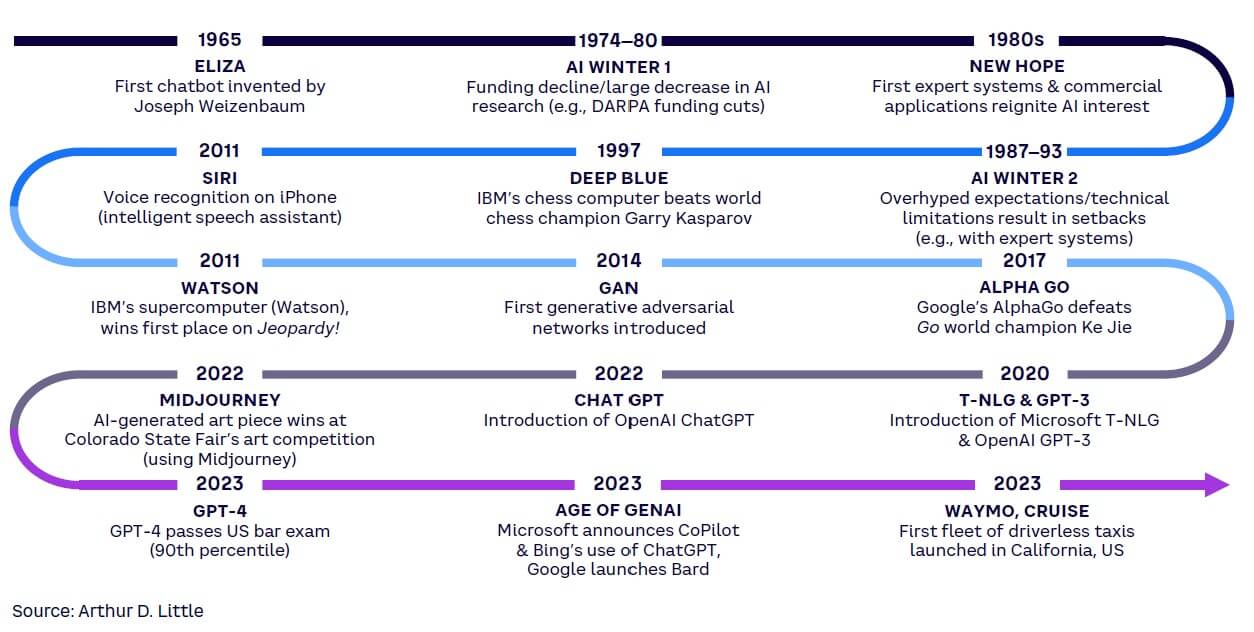
The potential to gain a competitive edge is sparking AI market adoption, including its solution/capability maturity, rapid use-case implementation, and increasing consumer readiness for AI. Beyond core use cases, AI exhibits radically transformative capabilities in newly emerging applications across industries. For example, Accor, Europe’s leading hospitality group, leveraged AI to automate time-consuming tasks, optimize resource allocation, and adjust pricing to meet demand volatility.
The result: strengthened customer loyalty via AI-customized recommendations.
As explored in the Arthur D. Little (ADL) Blue Shift Bulletin, “A Guest Role for AI,” AI technology has the potential to address key challenges faced by enterprises by making sense of large volumes of data. Such benefits are mainly derived via three techniques:
-
Classification (classifying data into predefined categories) — the ability to analyze past transaction data and/or customer interactions and identify those likely to churn, allowing for preventative measures
-
Regression (learning the relationship between input variables and outputs) — allowing the determination of optimal pricing levels based on a variety of inputs and outputs
-
Clustering (grouping of similar data) — enabling more sophisticated customer segmentations based on factors like purchase history and geography
Beyond these foundational techniques, AI empowers data management through automated data cleansing and anomaly detection, ensuring high-quality data that fuels accurate algorithms and insightful decisions. Advanced natural language processing (NLP) lets AI extract meaning from unstructured data like text and images, enriching the information landscape for insightful analysis.
A simplified distinction of non-generative versus GenAI can be used to provide a framework for AI comparison:
-
Non-generative AI — systems focused on processing and analyzing existing data, recognizing patterns, and making predictions without generating new content or creative outputs
-
GenAI — AI that can generate new content or create original outputs based on input variables from multiple data sets
GenAI (R)EVOLUTION IN CPAAS
Initially, AI in CPaaS was limited to basic chatbot/voice-recognition functions such as automated responses to common queries. Today, as GenAI unlocks more advanced CPaaS/CXaaS (customer-experience-as-a-service) applications, it is driving market hype and serving as a key source of future value for CPaaS players (see Figure 2).
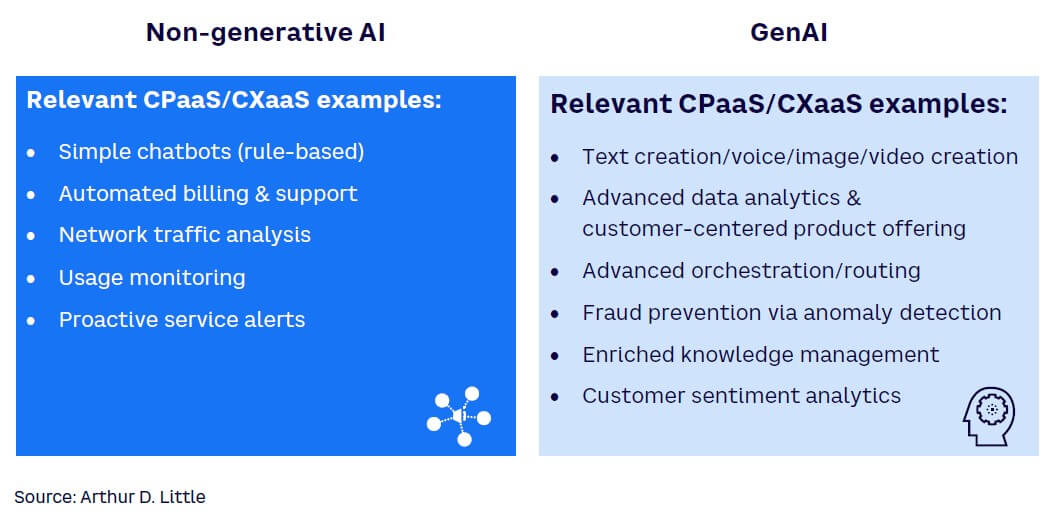
Specifically, GenAI presents a unique opportunity for CPaaS providers to develop enhanced offerings. By developing dynamic/interactive solutions that engage in a personalized, context-specific fashion, CPaaS providers can enhance end-user experiences, overcome the limitations of one-size-fits-all content, and foster deeper customer connections. GenAI’s ability to define rules for learning/adaptation over time facilitates continuous optimization of CPaaS offerings, ensuring differentiated market positioning for companies that master it.
Various CPaaS players are starting to venture into the AI space (see Figure 3). CPaaS solution providers have initially taken the lead. Twilio’s announcement of its 2023 partnership with Frame AI to extend its customer data platform (CDP) solutions is a good example of integrating GenAI capabilities into CPaaS offerings. Leveraging Frame AI’s consumer intelligence platform/capabilities, Twilio is poised to extend its existing solution suite to customer-intention and case-severity analysis. This will help Twilio’s clients train models that can define and categorize customer intentions for better product decisions.
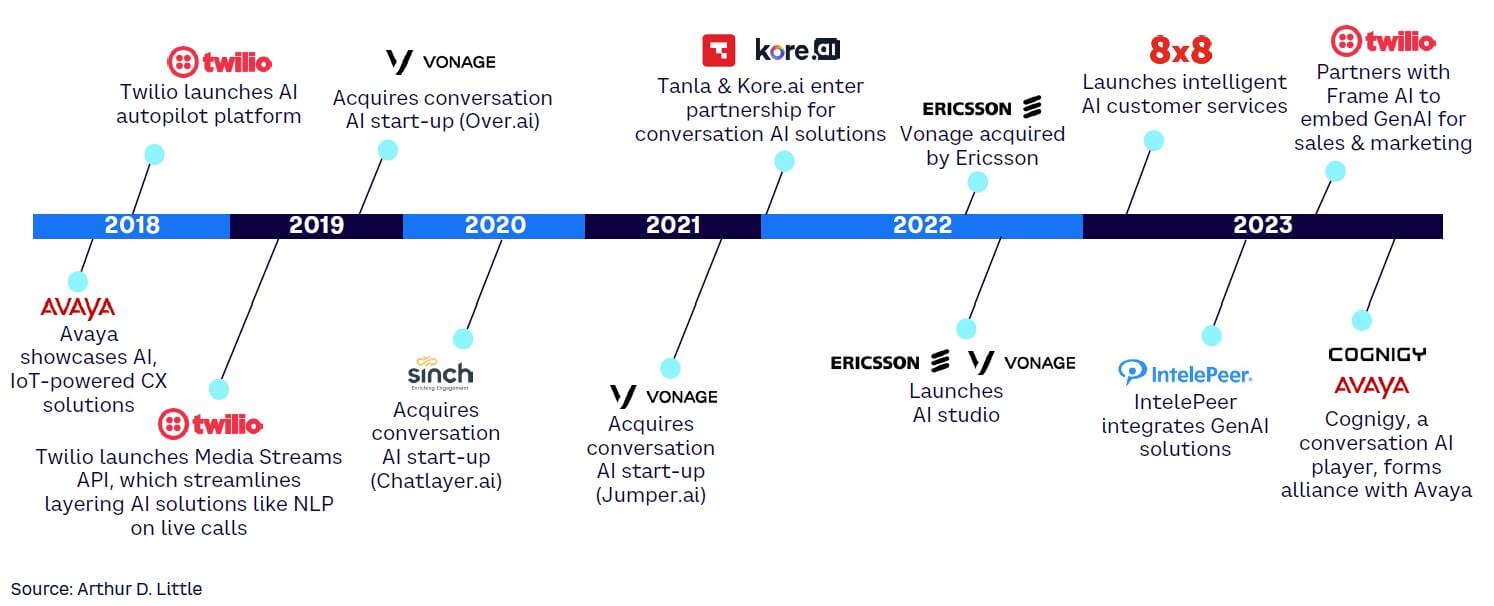
Other companies are emerging in this space, including IntelePeer, whose CEO Frank Fawzi highlights the huge opportunity AI presents for CPaaS players. Fawzi told ADL that CPaaS players can unlock significant potential via GenAI-enabled communication-automation platforms. “Recent experiences of enterprise customers show more than 80% of call center traffic opting for GenAI solutions over real agents — optimizing both operations and experiences,” said Fawzi.
As a result of these applications, GenAI is positioned to be one of the fastest growing subsegments within the global CPaaS market and is expected to reach approximately US $4.3 billion by 2027, representing approximately 6% of the global CPaaS market (forecast to reach $68.6 billion by 2027). These estimates stem from market expectations that as the technology matures, CPaaS market penetration will follow a ripple effect toward GenAI solutions (see Figure 4).
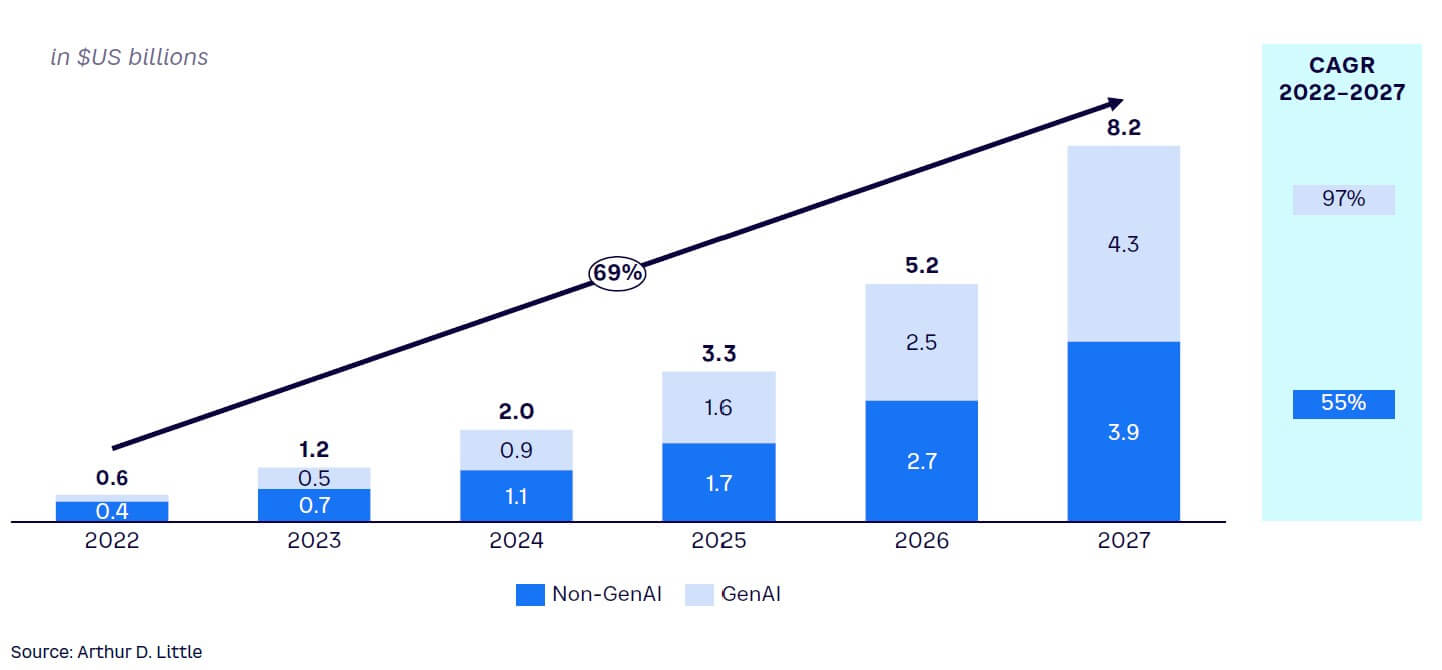
Although non-generative AI is expected to grow and remain important in the global CPaaS market (reaching approximately $3.9 billion by 2027), GenAI is identified as the key value source for CPaaS players in the coming years.
It is relevant to note that the scale of AI adoption within the CPaaS domain is dependent on overcoming potential hurdles across the market, including customer readiness, investment returns, and regulatory risks. Despite this, market trends demonstrate that customer and regulatory readiness is on the rise, with a wide-scale transition of CPaaS players to AI-powered solutions and the establishment of common AI regulatory frameworks (e.g., EU AIA). Furthermore, top-performing implementations can break even on initial investments within less than six months — presenting a highly attractive ROI for AI solution investment.
STRATEGIZING VIA SEGMENTATION
Of course, CPaaS players must be mindful about which segment(s) to target with GenAI and should identify natural combinations/integrations of use cases for an integrated offering. Figure 5 outlines the four principal areas of application for end-user provision, with relevant market examples highlighted for each segment:
-
Conversation/content creation — enabling enterprises to create personalized customer journeys (e.g., text-to-voice/voice-to-text translation and real-time textual sentiment analysis/adaptation)
-
CDP (data insights/personal recommendations) — intelligently recognizing customer intent and providing data-backed recommendations for better business decisions
-
Security/fraud prevention — stopping spam and phishing in real time using large language models (LLMs) and deep learning in GenAI (including future-pattern prediction), enhanced firewalling for mobile network operators (MNOs) to enable better network monetization beyond short message service (SMS) and voice, and advanced fraud-prevention applications (e.g., ATM fraud detection via detection of account owner’s mobile device in vicinity of the bank)
-
Routing/orchestration — GenAI-powered, real-time selection of optimal telco routing; most are in early rollout phase, with TelecomsXChange (TXCX) currently developing GenAI telecom routing strategies as a priority for 2023

Many use cases exist; Figure 6 highlights 10 GenAI applications that are strategically relevant for CPaaS players.
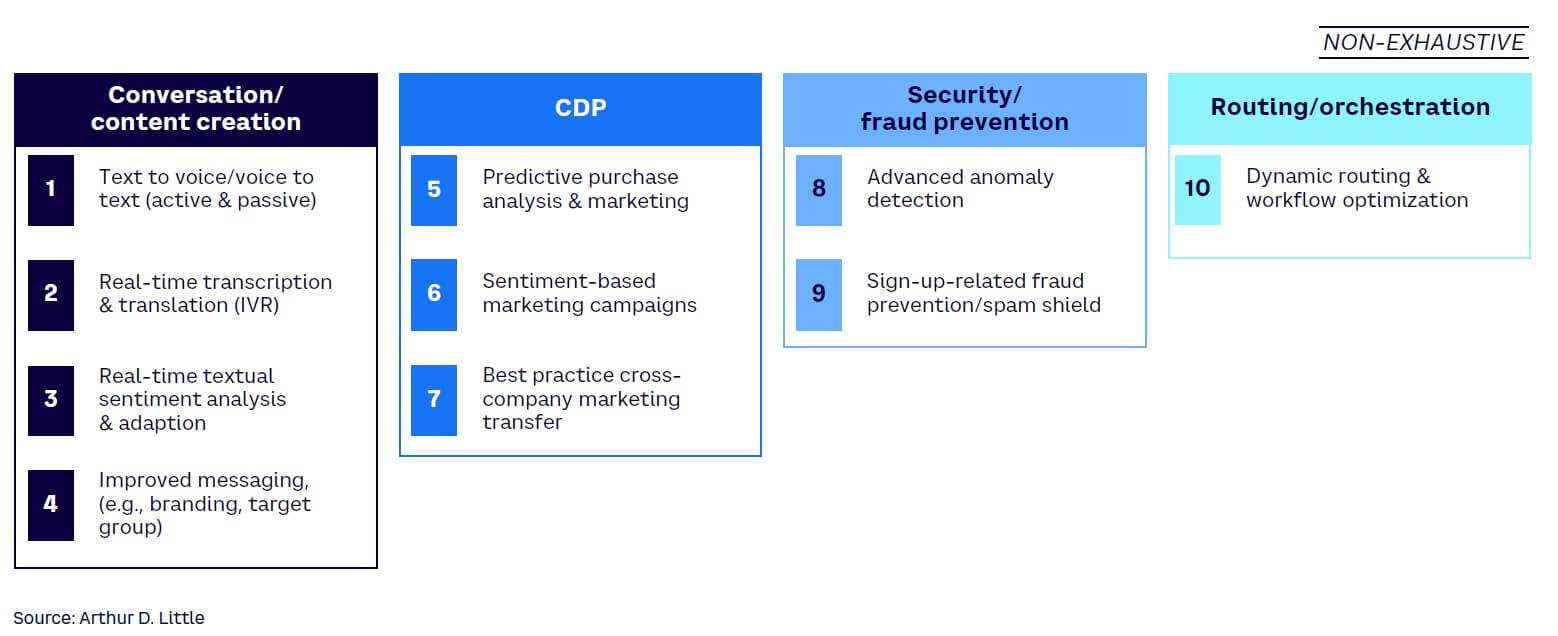
Below, we describe four specific examples within the four principal areas to provide a more contextualized view of the benefits GenAI holds for CPaaS players:
-
Conversation/content creation. Considerable potential is attributed to text-to-voice/voice-to-text (first pioneered by Google about five years ago) because it facilitates the transfer of text-to-speech output and verbal feedback processing, either actively (robocalls) or passively (call centers, helplines). Relevancy for CPaaS players is derived from the ability to:
-
Provide service offerings catering to content generation based on targeted/specific features (e.g., demography, sales channel).
-
Develop/use smart chatbots and communication solutions that help CPaaS players transition from static/generic marketing messaging to personalized (auditive) experiences with potential customer sentiment adaptation. GenAI can also be used to train/refine chatbots by creating large volumes of test scenarios.
-
-
CDP. Predictive purchase analysis and marketing is a key CPaaS application. With GenAI-enabled CDP, customers can store historic purchase data and leverage LLMs to identify new patterns in purchasing behavior, enabling sales recommendations at the most likely conversion time. Relevancy for CPaaS players derives from the ability to:
-
Build robust CDP toolkits that enable better engagement tools, leveraging available customer data to create more relevant communication strategies and improve customer rapport.
-
Provide a target offering for small and medium-sized businesses (SMBs) — a quickly growing segment — which often lack proper in-house sales suites and the ability to conduct large-scale customer analyses. GenAI-enabled CDP can be based on shared customer data/insights, letting marketers learn from the platform offering and tailor commercial efforts.
-
-
Security/authentication. GenAI supports enhanced firewalling for MNOs (via dynamic/adaptive firewall rules that evolve in real time) that enables network monetization beyond SMS and voice. Emerging applications focused on sign-up-related fraud prevention/spam shield offer additional commercial potential, leveraging GenAI pattern detection to reduce the negative business impacts of fraudulent accounts. CPaaS players gain the ability to:
-
Add value to corporate enterprises that do not have the resources to invest in their own solution development.
-
Provide a communication platform that also authenticates customers, ensuring efficient deployment of resources to build relations with verified customers only.
-
-
Routing/orchestration. Smart routing automation is becoming prevalent in the market, with solutions such as Vonage’s Dynamic Call Routing using a self-learning, algorithm-based mechanism to ensure high quality. GenAI will play a critical role by facilitating the implementation of dynamic traffic-type categorization. Using GenAI-powered pattern detection, these applications will be able to categorize traffic (especially wholesale traffic), serving as an input for optimal routing, with one-time password-identified messages sent via low-latency, priority routes. CPaaS players will be able to:
-
Increase margins on messaging traffic via optimal route selection (lowest cost route that still provides the required quality).
-
Automate human-led, manpower-intensive categorization of transmitted traffic.
-
CONSIDERING IMPACT ON TELCO ECOSYSTEM
GenAI will generate considerable benefits for the CPaaS space, but its impact on the wider ecosystem must be considered. There are several opportunities and risks posed to CPaaS players, enterprises, and telcos:
-
Opportunities for CPaaS players. Using the power of GenAI, CPaaS players will be able to move up the value chain and target segments previously untouched (e.g., content creation). In this setting, CPaaS players can offer value-add services to their customers, such as bundling content generation with message orchestration, and move toward a software-as-a-service offering compared to current transactional models. This will help them unlock further value via increased stickiness of customers and greater service margins.
-
Opportunities for enterprises. We see significant potential for customers from SMBs to multinational enterprises. While the latter can further increase the effectiveness of their marketing campaigns via improved data analysis and predictive models, SMBs can access an effective toolkit for targeted, personalized customer interaction. By combining CPaaS with a GenAI-enabled CXaaS suite, SMBs will have an easy-to-use, no-code, one-stop shop for all customer interactions, from content creation to cross-channel information transmission.
-
Opportunities for telcos. With GenAI, marketing messaging will move toward visual formats (images, videos) and away from traditional text messages. This is expected to have a disruptive effect on bulk SMS-related marketing activities, with considerable impact on telco revenues. However, telcos can take advantage of this shift by leveraging their strong salesforce in the B2B segment to promote their own (or a third-party) GenAI-based CPaaS product to SMBs and others.
-
Flip side of the coin. Integration of GenAI technology within CPaaS players, enterprises, and telcos may encounter regulatory obstacles (e.g., evolving legal frameworks and the requirement for uniformity across legal jurisdictions). Variance in data-privacy regulations and concerns about potential bias/misuse of AI-generated content pose compliance hurdles that will need to be overcome. Adaptation to evolving legal landscapes demands agility, and achieving uniformity across legal jurisdictions requires a balance between local compliance and global innovation.
Ultimately, GenAI will fuel the CPaaS ecosystem, benefiting CPaaS players, enterprises, and other entities in the telco ecosystem that manage to unlock this potential. Only by proactively adopting these applications will companies be able to turn GenAI into a golden bullet for their operations.
Conclusion
IS GenAI THE FUTURE OF CPAAS?
Players that harness GenAI’s potential can strategically differentiate themselves in the CPaaS space. Key takeaways for those looking to unlock GenAI opportunities include:
-
AI and ML are revolutionizing industries, with CPaaS players poised to seize GenAI opportunities.
-
GenAI enables dynamic, interactive solutions for personalized, context-specific experiences, potentially revolutionizing existing CPaaS offerings.
-
Key applications for GenAI in CPaaS are conversation/content creation, CDP data insights, security/fraud prevention, and routing/orchestration.
-
Strategic targeting of segments and use cases is required (this is crucial to maximize GenAI’s potential).
-
Continuous optimization of GenAI offerings ensures differentiated market positioning for CPaaS providers that can harness its potential.
-
GenAI use cases yield a range of new opportunities across CPaaS players, enterprises, and other entities in the telco ecosystem.



